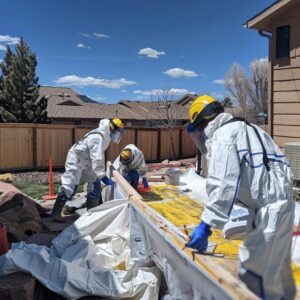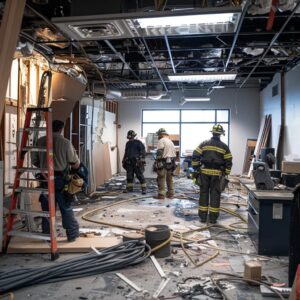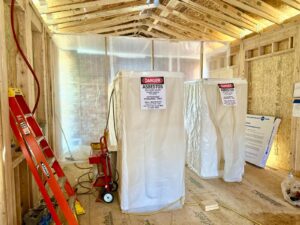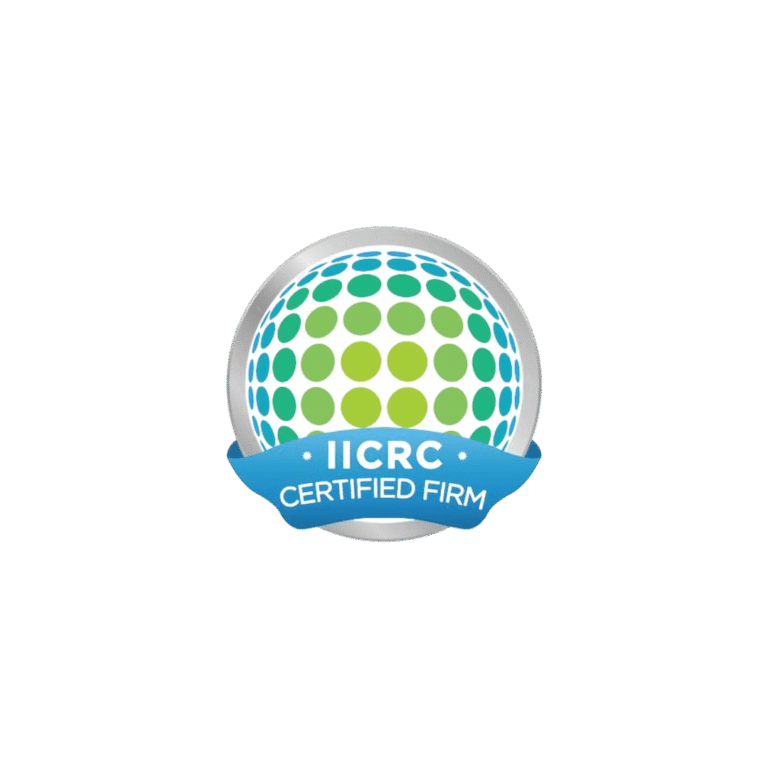Denver Asbestos Abatement Regulations: A Complete Owner's Guide
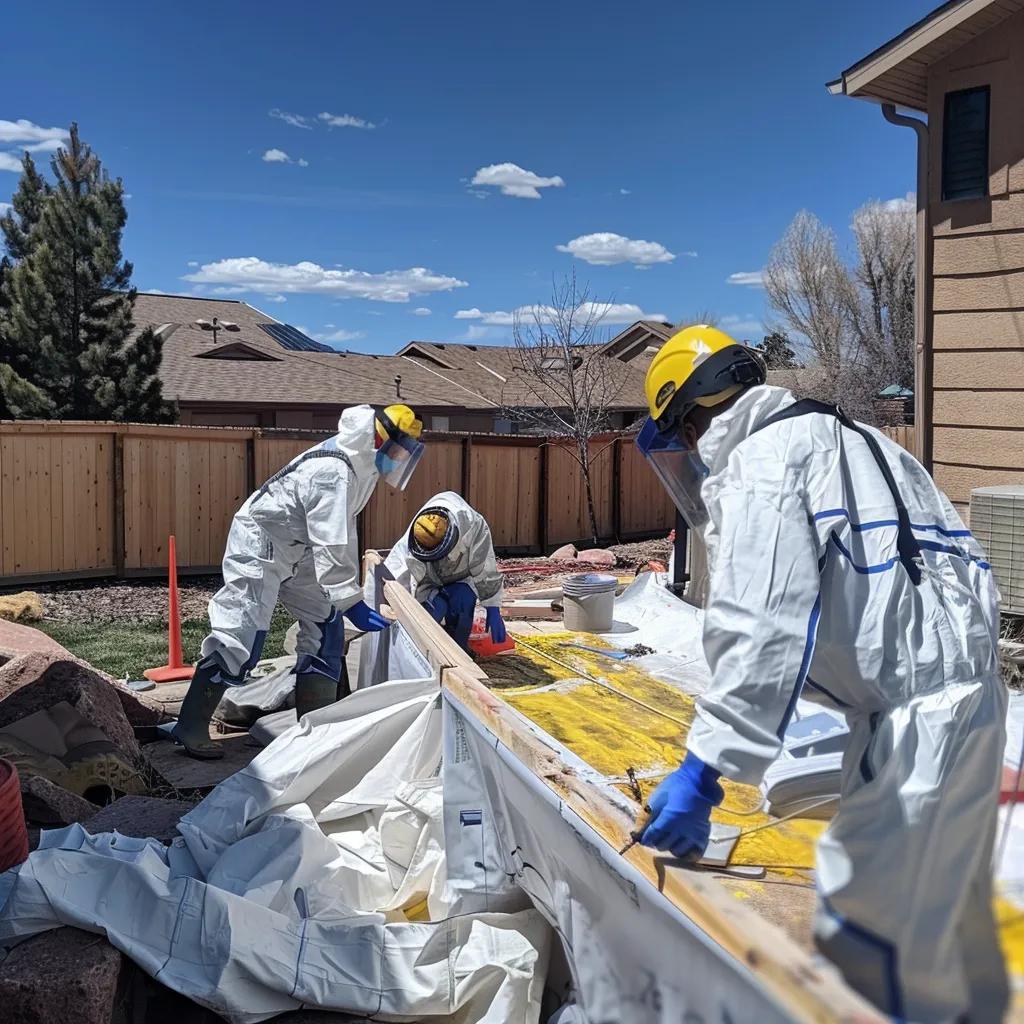
Denver property owners face strict asbestos abatement Denver regulations designed to protect public health and avoid costly enforcement actions. Navigating these rules can feel overwhelming, but understanding the roles of governing agencies, mandatory inspections, permit requirements, and safe removal practices will ensure compliance and peace of mind. This complete guide explains key regulations, the inspection trigger points, step-by-step abatement procedures, contractor qualifications, and distinctions between friable versus non-friable materials, as well as residential and commercial obligations. You’ll learn how to choose a licensed abatement firm—such as Elyon Restoration—and when to call for a free estimate or emergency service.
In this guide you will discover:
- What Are the Key Asbestos Abatement Regulations in Denver?
- When and Why Is an Asbestos Inspection Required in Denver?
- How Does the Asbestos Abatement Process Work in Denver?
- How to Hire a Licensed Asbestos Abatement Contractor in Denver?
- What Are the Differences Between Friable and Non-Friable Asbestos in Denver Regulations?
- What Are the Specific Asbestos Regulations for Residential vs. Commercial Properties in Denver?
- Common concerns and next steps for free estimates or emergency response
What Are the Key Asbestos Abatement Regulations in Denver?
The primary framework for asbestos abatement in Denver is enforced by the Colorado Department of Public Health and Environment under Regulation 8 Part B, along with federal OSHA and EPA standards. These regulations define trigger levels, notification and permit requirements, and disposal protocols to ensure that removal projects safeguard worker and community health. Understanding these rules is essential before planning any demolition or renovation.
Colorado Department of Public Health and Environment (CDPHE) Regulations
The Colorado Department of Public Health and Environment (CDPHE) is the primary agency responsible for enforcing asbestos abatement regulations in Denver, as outlined in Regulation 8 Part B. These regulations establish the framework for managing asbestos, including requirements for inspections, notifications, permits, and disposal protocols to protect public health and the environment.
This citation supports the article’s claims about the governing agencies and the legal framework for asbestos abatement in Denver.
Which Agencies Govern Asbestos Abatement in Denver and Colorado?

Three main entities share authority over asbestos abatement in Denver, each with defined responsibilities to enforce safe practices and compliance.
| Entity | Role | Responsibility |
|---|---|---|
| Colorado Department of Public Health and Environment (CDPHE) | State regulator | Enforces Regulation 8 Part B, issues abatement permits, approves notifications |
| U.S. Environmental Protection Agency (EPA) | Federal environmental safeguards | Sets national asbestos handling standards, oversees disposal rules |
| Occupational Safety and Health Administration (OSHA) | Worker safety regulator | Mandates worker protection protocols, air monitoring, PPE requirements |
U.S. Environmental Protection Agency (EPA) and OSHA Standards
The U.S. Environmental Protection Agency (EPA) sets national standards for asbestos handling and oversees disposal rules, while the Occupational Safety and Health Administration (OSHA) mandates worker protection protocols. These federal agencies work in conjunction with state and local entities to ensure comprehensive safety measures are in place during asbestos abatement projects.
This citation supports the article’s claims about the roles of federal agencies in asbestos abatement and their impact on worker safety and environmental protection.
Each agency’s oversight ensures that asbestos projects comply with both public health and workplace safety standards. Next, we’ll explore the core legal framework of Regulation 8 Part B.
What Is Colorado Regulation 8 Part B and How Does It Affect Denver Property Owners?
Colorado Regulation 8 Part B defines asbestos as a hazardous pollutant and sets threshold quantities for mandatory inspection, notification, and permits. Any renovation or demolition disturbing more than 160 square feet of material—or any quantity of friable asbestos—triggers Part B requirements.
Key points include:
- Mandatory pre-demolition inspection by a certified inspector.
- Written notification to CDPHE at least ten working days before work begins.
- Permit application detailing project scope, abatement plan, and disposal site.
These provisions protect occupants and contractors by requiring hazard identification and approved containment plans. With permits secured, owners move on to notification steps that follow.
What Are the Legal Requirements for Asbestos Notification and Permits in Denver?
Property owners must follow a precise notification and permitting timeline to comply with Denver regulations before abatement work.
- Submit a written Notification of Intent form to CDPHE at least ten business days before disturbance.
- Obtain a Demolition or Renovation Permit from the City and County of Denver, specifying project location and scope.
- Provide copies of laboratory analysis results demonstrating asbestos presence or clearance.
Meeting these requirements prevents project delays and enforcement actions. Once permits are approved, contractors can begin the abatement process under safety protocols.
What Are the Penalties for Non-Compliance with Denver Asbestos Regulations?
Denver enforces steep penalties for failing to comply with asbestos rules, including:
- Administrative fines up to $25,000 per violation.
- Stop-work orders that suspend all demolition or renovation activities.
- Civil or criminal charges for deliberate violations.
Strict enforcement underscores the importance of following CDPHE, EPA, and OSHA mandates. Ensuring proper inspection, notification, and licensed abatement prevents these serious consequences and protects health.
When and Why Is an Asbestos Inspection Required in Denver?
An asbestos inspection is mandatory before most demolition or renovation projects in Denver to identify hazardous materials and safeguard occupants.
Who Must Get an Asbestos Inspection Before Renovation or Demolition?
Any property owner planning to disturb more than 160 square feet of suspect material, or any quantity of friable asbestos, must arrange an inspection. This requirement applies to:
- Residential homes undergoing major remodels.
- Commercial buildings scheduled for demolition or extensive upgrades.
- Owners of historic structures with likely legacy asbestos materials.
Ensuring an inspection avoids unplanned stoppage and aligns with Regulation 8 Part B trigger levels.
What Does a Certified Denver Asbestos Inspection Involve?

A certified inspection follows a standardized four-step process:
- Visual survey of suspect asbestos-containing materials.
- Collection of material samples using sealed containment.
- Laboratory analysis confirming asbestos percentage.
- Detailed report outlining locations, material types, and recommended abatement methods.
This thorough assessment identifies risk areas and informs the abatement plan that follows.
How to Choose a Certified Asbestos Inspector in Denver?
Selecting a qualified inspector involves verifying:
- State certification and CDPHE credentials.
- Minimum of three years’ experience with Colorado asbestos projects.
- Accredited laboratory partnerships for reliable analysis.
Choosing an experienced provider such as Elyon Restoration’s inspection team ensures accurate results and clear guidance on next steps.
What Is the Typical Cost and Process for Asbestos Testing in Denver?
Testing costs generally range from $300 to $800, depending on:
- Number of samples collected.
- Distance to the certified laboratory.
- Complexity of property layout.
The process—from site visit to report delivery—often takes 7–10 business days, allowing owners to schedule abatement promptly once results confirm hazards.
How Does the Asbestos Abatement Process Work in Denver?
Asbestos abatement in Denver follows a defined sequence from inspection to final clearance, ensuring safe removal and lawful disposal.
What Are the Steps from Inspection to Final Abatement?
The abatement workflow includes:
- Inspection: Certified survey identifies asbestos locations.
- Planning: Develop work plan detailing containment and removal methods.
- Notification & Permits: Submit notifications and secure CDPHE and Denver permits.
- Containment & Removal: Licensed contractors isolate work areas, apply negative air pressure, and remove materials.
- Air Monitoring & Clearance: Conduct final air sampling to verify safe levels.
- Disposal: Transport waste under manifest to approved landfills.
This structured approach guarantees both legal compliance and occupant safety throughout removal.
How Are Permits Obtained and What Notifications Are Required?
Permit acquisition involves:
- Submitting an Asbestos Permit Application form with project details.
- Attaching the inspection report and abatement plan.
- Notifying the City and County of Denver ten business days prior to abatement.
Timely submission ensures no delays in mobilizing licensed abatement crews.
What Safety Protocols Must Licensed Contractors Follow?
Licensed contractors must:
- Erect sealed containment barriers with warning signage.
- Use HEPA-filtered negative air machines to prevent fiber release.
- Wear full-body protective suits and respirators with P100 filters.
- Conduct daily and final air monitoring to confirm clearance levels below 0.01 fibers/cc.
Adhering to these standards protects workers and building occupants at every stage.
How Is Asbestos Waste Safely Disposed of in Denver?
Disposal follows strict rules:
| Entity | Attribute | Value |
|---|---|---|
| Waste Packaging | Double-sealed bags | Polyethylene bags labeled “Asbestos Waste” |
| Transportation | Waste manifest | Includes generator name, volume, and landfill ID |
| Approved Landfills | Location | Facilities certified by CDPHE for asbestos waste |
All manifests and sealed containers must arrive at approved landfills, closing the abatement cycle and ensuring environmental safety.
How to Hire a Licensed Asbestos Abatement Contractor in Denver?
Hiring the right abatement firm secures compliance, safety, and project efficiency.
What Certifications and Licenses Should Denver Contractors Have?
A qualified contractor must hold:
- Colorado CDPHE Asbestos Abatement Contractor license.
- EPA accreditation for asbestos worker training.
- OSHA certification for respirator fit-testing and air monitoring.
Verifying these credentials ensures the team meets all regulatory training and performance standards.
Why Choose Elyon Restoration for Denver Asbestos Abatement?
Elyon Restoration brings:
- Certified specialists available 24/7 for emergency response.
- Strict adherence to CDPHE, EPA, and OSHA protocols.
- End-to-end services from inspection to final clearance.
This combination of expertise, rapid deployment, and customer care delivers a seamless abatement experience.
What Questions Should Property Owners Ask Potential Contractors?
When interviewing contractors, confirm:
- How many Denver asbestos projects have you completed?
- Can you provide current CDPHE license and insurance documents?
- What is your air monitoring and clearance procedure?
- Do you manage disposal manifests and landfill coordination?
These inquiries reveal true proficiency and project reliability.
What Are the Differences Between Friable and Non-Friable Asbestos in Denver Regulations?
Regulations distinguish between friable and non-friable asbestos based on release potential and required handling methods.
How Do Friable and Non-Friable Asbestos Impact Abatement Procedures?
Friable asbestos—materials that can crumble by hand—pose higher airborne fiber risk and require full containment and negative-pressure removal. Non-friable materials must be kept wet and removed carefully but may allow less stringent enclosure methods.
Which Building Materials Commonly Contain Friable or Non-Friable Asbestos?
Common examples include:
- Friable: spray-on fireproofing, pipe insulation, duct wrap.
- Non-Friable: vinyl floor tiles, roofing shingles, cement siding.
Identifying material types shapes the abatement plan and safety controls needed.
How Do Regulations Define and Treat Friable Asbestos Differently?
Regulation 8 Part B sets lower disturbance thresholds for friable asbestos (any quantity) versus 160 square feet for non-friable materials. This distinction requires earlier notification and more rigorous engineering controls for friable removal.
What Are the Specific Asbestos Regulations for Residential vs. Commercial Properties in Denver?
Denver regulations assign different responsibilities and trigger levels for home and business owners.
What Are Residential Property Owner Responsibilities Under Denver Regulations?
Homeowners must:
- Arrange a pre-renovation inspection if any suspect material is disturbed.
- Provide inspection reports to contractors.
- Ensure licensed abatement and disposal.
These steps protect occupants and maintain property value during remodels.
How Do Commercial Property Regulations Differ in Denver?
| Entity | Attribute | Value |
|---|---|---|
| Trigger Level | Non-friable | 160 sq ft disturbance |
| Trigger Level | Friable | Any amount |
| Notification Period | Working days | 10 days to CDPHE and Denver Permitting Office |
Businesses face stricter enforcement and higher fines, making early compliance essential for uninterrupted operations.
Are There Special Considerations for Historic or Older Buildings in Denver?
Historic structures often harbor hidden asbestos in plaster, tiles, and insulation. Owners must coordinate with preservation authorities to secure any additional permits, while following the same CDPHE notification and abatement protocols.
What Are Common FAQs About Asbestos Abatement Denver Regulations?
Property owners often seek clear answers on bans, timelines, DIY limits, and service access related to Denver asbestos rules.
Is Asbestos Completely Banned in Denver or Colorado?
Asbestos is not fully banned but is highly regulated. Colorado permits certain legacy materials to remain in place if undisturbed, while any planned disturbance triggers strict abatement requirements under Regulation 8 Part B.
How Long Does the Asbestos Abatement Process Take in Denver?
A typical residential abatement runs 3–5 business days from containment setup through final clearance sampling. Larger commercial projects may extend over several weeks depending on scale and site complexity.
Can Property Owners Perform Asbestos Removal Themselves in Denver?
No, state law prohibits unlicensed individuals from handling asbestos. Only CDPHE-certified abatement contractors may remove and dispose of asbestos, ensuring licensed professionals manage all safety protocols.
How Can I Get a Free Estimate or Emergency Asbestos Service in Denver?
For a complimentary project estimate or 24/7 emergency response, call Elyon Restoration’s Denver team at (720) 555-1234. Licensed specialists will assess your property and provide a transparent plan within hours.
Recommended Schema.org Markup for This Content
- Use LocalBusiness schema for Elyon Restoration with properties: name, address, telephone, openingHours, serviceType “Asbestos Abatement.”
- Implement Service schema nested under LocalBusiness for “Asbestos Abatement Service,” including areaServed: “Denver, CO” and provider: “Elyon Restoration.”
- Apply Legislation schema for “Colorado Regulation 8 Part B” with properties: name, jurisdiction, dateModified, text.
- Use Permit or CreativeWork schema for the “Asbestos Abatement Permit,” linking issuedBy: “CDPHE.”
- Embed a HowTo schema for the abatement process with each step as HowToStep.
- Add FAQPage schema for the four common questions under “What Are Common FAQs…” to enable rich results.
Suggested Image Filenames and ALT Text for Multimodal Optimization
- Filename: cdphe-regulation-8-part-b-asbestos-denver.jpg ALT: “Colorado Department of Public Health and Environment Regulation 8 Part B document for Denver asbestos abatement.”
- Filename: licensed-asbestos-contractor-denver-ppe.jpg ALT: “Licensed asbestos abatement contractor in Denver wearing protective suit and respirator.”
- Filename: denver-asbestos-abatement-process-flowchart.png ALT: “Flowchart of the Denver asbestos abatement process: inspection, permits, removal, disposal.”
- Filename: friable-vs-nonfriable-asbestos-denver-table.png ALT: “Table comparing friable versus non-friable asbestos definitions and regulatory thresholds in Denver.”
Denver property owners who follow these regulations protect occupants, avoid fines, and preserve property value. By scheduling a certified inspection, obtaining proper permits, and hiring a licensed abatement contractor like Elyon Restoration, compliance becomes a structured, reliable process. Understanding distinctions between material types and property categories ensures that every project meets CDPHE, EPA, and OSHA standards. For expert guidance and a free estimate, contact Elyon Restoration’s Denver team today.

